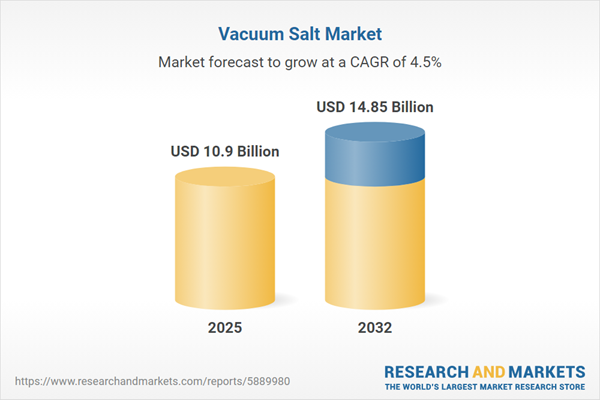Speak directly to the analyst to clarify any post sales queries you may have.
Senior decision-makers in the vacuum salt market must navigate evolving regulations, supply complexities, and rigorous procurement standards. Gaining a clear understanding of operational risks, supply resilience, and shifting buyer expectations is essential for developing sustainable sourcing strategies in this dynamic landscape.
Vacuum Salt Market Snapshot
The global vacuum salt market is expanding steadily, anchored by strong demand across food processing, chemical manufacturing, pharmaceuticals, water treatment, and deicing applications. In 2024, the sector reached a USD 10.43 billion valuation, with continued growth anticipated at a CAGR of 4.50%. Projections expect the market to reach USD 10.90 billion by 2025 and USD 14.85 billion by 2032. Heightened global competition and increasing quality expectations are leading stakeholders to implement advanced sourcing structures and stricter standards. Regional market dynamics and compliance conditions are also requiring more adaptive procurement approaches, bolstering operational stability and asset protection for industry leaders.
Scope & Segmentation of the Vacuum Salt Market
This vacuum salt market report supports C-level executives in making informed sourcing and procurement decisions. Detailed segmentation enables alignment of operational models with compliance, efficiency, and customer expectations.
- Type: Food grade vacuum salt addresses ingredient control for food-sector needs; industrial grades underpin a variety of operational uses; pharmaceutical grade ensures compliance for regulated industries.
- Application: Chemical processing, food and beverage manufacturing, water treatment, deicing, and pharmaceutical uses demonstrate the market’s wide relevance for consistency and reliability.
- Distribution Channel: Includes direct contracts, project agreements, wholesale and retail, digital procurement, and third-party e-commerce, ensuring diverse supply options and risk mitigation.
- Purity Grade: High Purity (99–99.5%, 99.5–99.9%), Ultra High Purity (above 99.9%), and Standard Purity (97–98%, 98–99%) match different regulatory or process efficiency requirements.
- Geography: Market presence spans the Americas, Europe, Asia-Pacific, Middle East, and Africa, with regional differences influencing sourcing frameworks and compliance efforts.
- Leading Companies: Compass Minerals International, K+S Aktiengesellschaft, Cargill, Tata Chemicals, Salins Société Anonyme, Morton Salt, Shandong SALCO Salt Chemical, Ciech, and Cheetham Salt Limited drive changes in technology use, reliability, and procurement standards.
Understanding the segmentation framework equips leaders to tailor procurement strategies, advance crystallization technologies, and address both regulatory shifts and customer-driven market changes across all regions.
Vacuum Salt Market: Key Takeaways for Senior Decision-Makers
- Crystallization and evaporation innovations upgrade product quality, improve traceability, and simplify operations throughout the supply chain.
- Digital procurement tools enable faster market responses and enhance transparency from sourcing through to delivery, benefiting every stakeholder.
- Pursuing sustainability involves integrating renewable energy and refining water use in both production and distribution phases.
- Regionally specialized sourcing and more robust supplier relationships help secure operations against geopolitical or logistical disruptions.
- Purity standards and strengthened quality assurance are vital for serving highly regulated and sensitive product markets.
- Collaborative supply chain frameworks promote transparency and help partners align with compliance goals and evolving client requirements across jurisdictions.
Tariff Impact on Procurement and Supply Chain
Changing tariff environments are prompting leaders to diversify suppliers closer to end-user markets, which stabilizes pricing and reinforces delivery continuity. Successful supply chain strategies now require ongoing supplier vetting and flexible sourcing methods to absorb market or regulatory volatility.
Methodology & Data Sources
This vacuum salt market analysis integrates direct industry input, comprehensive sector research, and audited company data. Independent validation and peer review maintain accuracy and relevance for executive-level strategies and decision-making.
Why This Vacuum Salt Market Report Matters
- Delivers actionable market intelligence to improve procurement outcomes, enhance sourcing efficiency, and drive informed technology integration from producer to end user.
- Supports benchmarking for sustainability efforts and develops agile processes that strengthen organizations in established and emerging markets.
- Prepares decision-makers to respond effectively to regulatory changes and evolving market forces, securing supply chains and optimizing risk management.
Conclusion
Advancements in technology, adaptive regulatory strategies, and robust supply chain management are now fundamental within the vacuum salt market. This report provides the practical context and market clarity needed to guide sustainable decision-making.
Additional Product Information:
- Purchase of this report includes 1 year online access with quarterly updates.
- This report can be updated on request. Please contact our Customer Experience team using the Ask a Question widget on our website.
Table of Contents
3. Executive Summary
4. Market Overview
7. Cumulative Impact of Artificial Intelligence 2025
Companies Mentioned
The companies profiled in this Vacuum Salt market report include:- Compass Minerals International, Inc.
- K+S Aktiengesellschaft
- Cargill, Incorporated
- Tata Chemicals Limited
- Salins Société Anonyme
- Morton Salt, Inc.
- Shandong SALCO Salt Chemical Co., Ltd.
- Ciech S.A.
- Cheetham Salt Limited
Table Information
| Report Attribute | Details |
|---|---|
| No. of Pages | 188 |
| Published | November 2025 |
| Forecast Period | 2025 - 2032 |
| Estimated Market Value ( USD | $ 10.9 Billion |
| Forecasted Market Value ( USD | $ 14.85 Billion |
| Compound Annual Growth Rate | 4.5% |
| Regions Covered | Global |
| No. of Companies Mentioned | 10 |









